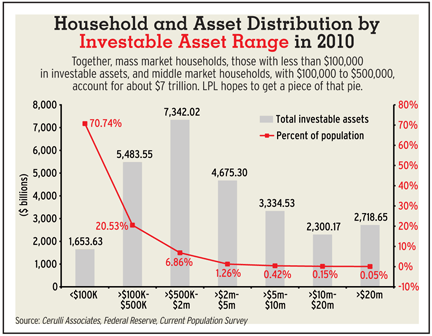LPL Financial announced plans Wednesday to launch a new subsidiary, LPL New Venture, which will use rookie advisors to focus on part of the mass and middle market. In addition to exploiting a largely untapped market, the firm sees it as a training ground for younger advisors and career changers.
The “mass market” accounts for 70.74 percent of households holding $1.65 trillion, according to data by Cerulli Associates. These investors have up to $100,000 in investable assets. Meanwhile, the “middle market” makes up 20.5 percent of households holding $5.4 trillion, with $100,000 to $500,000 in investable assets.
The firm intends to serve the 32 million households that straddle the line between these segments. According to LPL studies, 70 percent of consumers in the mass market would like financial advice but only 25 percent have ever had access to it.
Esther Stearns, the firm’s president and chief operating officer, will step down from her role to head up the new venture as CEO. “We’ve noticed that in the last decade, the number of financial advisors serving American consumers has stagnated, and at the same time, there’s a growing need for financial advice,” she said.
The program will be focused on fee-based RIAs, who will not be on LPL’s brokerage platform. Advisors will go through about 12 to 24 months of training, and afterwards, graduates will become independent contractors.
But there is a real challenge to serve these smaller markets profitably, said Scott Smith, an analyst with Cerulli Associates.
Edward Jones and Waddell & Reed have succeeded in doing so, Smith said, but its unclear what LPL’s strategy will be. The firm would not share many details. Smith believes one option could be a direct business model, similar to Fidelity. There the advice the client is getting on investments and asset allocation is coming through a managed accounts program, not from the advisor’s personal contact. In other words, they wouldn’t have a lot of discretion over the client’s portfolio.
“Quite frankly, I don’t want a 26-year-old, who’s been doing this for two years, running my portfolio on a daily basis.”
Under this scenario, the goal would probably be to charge a 1 percent fee to run a mutual fund wrap program, Smith said. “There’s probably more upside there for long-term profit.”
There may be some degree of personalization, but the advice would come through a centralized advice engine, rather than delegating those decisions to the field. The value would come through existing programs and platforms, Smith said.
Because these are likely going to be younger advisors, prospective clients would also likely come from a centralized lead generation engine, Smith speculates.
“If they’re new to the industry, just out of college, I can’t imagine them being handed a phonebook and saying, ‘go gather assets.’ Everyone’s kind of throwing that model out with the bathwater.”
Leg Up on Younger Investors, Advisors
These days, firms are struggling to react to the emerging wealth of Generations X and Y, but the new subsidiary could help LPL take advantage of that.
“On a widespread basis, there’re a lot of firms worried about filling their pipeline with younger investors,” Smith said. “And I think this will probably give LPL a leg up on doing that by having younger, more approachable advisors who have a peer group there who can use their network to a certain extent.”
But the move could also attract younger advisors into the industry. There are very few natural training grounds right now in the industry, and this could be that training grounds, Smith said.
An added benefit, Smith said, is that the program provides a great recruiting set for LPL’s existing advisors. Perhaps once these advisors serve five years in the program and outgrow the role, they can be added to a team as a productive member, rather than having teams out there looking to recruit rookies, Smith said.
“We’re all worried about the graying of the advisor force.”
Executive Shuffle
As part of the new initiative, LPL reorganized its senior leadership, tapping Robert Moore, the firm’s chief financial officer, to take over Stearns duties as president and COO as of May 1. Moore will continue to carry out his CFO responsibilities until a replacement is found. Meanwhile, Bill Dwyer, president of national sales, will now oversee th e firm’s sponsor relations function.
e firm’s sponsor relations function.
Moore’s responsibilities as CFO were expanded in the past to include many advisor-facing aspects of the firm’s business. He oversees Fortigent, LPL’s newly acquired research and reporting firm that serves RIAs, as well as the firm’s insurance businesses. With the IPO behind it and the establishment of a capital structure LPL has reached a point where they could identify a successor for the CFO position. Moore has been in that role since he joined the firm in September 2008.


